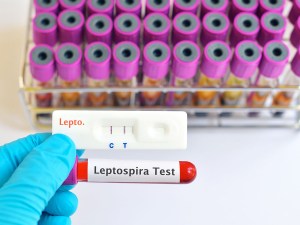Leptospirosis, sometimes referred to as “lepto”, is a disease caused by Leptospira bacteria. The disease affects almost all mammals, including people, dogs, and cats. Effects can range from mild, with almost no symptoms, to multiple-organ failure and death.1
1. Leptospirosis is found worldwide
Leptospirosis is most common in warm environments but it can be found all over the world. It can be found in water or soil in both rural and urban environments.2
2. Leptospirosis risk increases after flooding or heavy rainstorms
Although they can be found almost anywhere, Leptospira bacteria prefer warm weather and wet environments. These bacteria can be found in rivers, lakes, creeks, and puddles. Risks are higher in flooded or recently flooded areas.2 The infective bacteria can survive in surface waters for extended periods.1
3. Leptospirosis is transmitted by wildlife and domestic animals
Leptospirosis can be transmitted by a variety of wildlife, including rodents, raccoons, and opossums. It can also infect (and be spread by) cattle, swine, horses, and other domestic livestock.3 Pets that are exposed to wildlife and livestock are considered to be at risk for lepto.3 Dogs that have contact with wildlife, swim, or roam are especially at risk. Infected animals shed bacteria in their urine.
4. Leptospirosis is both a city and a country dog disease
We’ve already mentioned that dogs in rural environments are at risk. Contact with wildlife and livestock and access to streams, ponds, and other bodies of water are all risk factors. But dogs in urban and suburban environments are also at risk for this disease. Some types of “wildlife”, such as raccoons and rodents, are common in many cities and suburbs, and leptospirosis can be spread by their urine.
5. Leptospirosis vaccination can help prevent disease
Leptospirosis vaccines are effective in helping prevent disease, and some vaccines are actually proven to prevent the shedding of bacteria. Because leptospirosis can be spread through the urine of infected wild and domestic animals, and every dog is at risk, prevention through vaccination is extremely beneficial.4
Talk with your veterinarian about products such as NOBIVAC® Lepto4 and NOBIVAC Edge® Lepto4.
Authored by Nyssa Reine-Salz
References:
1. Lunn, Katharine. Leptospirosis in Dogs. Merck Manual Veterinary Manual. https://www.merckvetmanual.com/dog-owners/disorders-affecting-multiple-body-systems-of-dogs/leptospirosis-in-dogs
2. Leptospirosis. Centers for Disease Control and Prevention. https://wwwnc.cdc.gov/travel/diseases/leptospirosis
3. Leptospirosis Fact Sheet. Centers for Disease Control and Prevention. https://www.cdc.gov/leptospirosis/resources/leptospirosis-fact-sheet.html
4. Leptospirosis. American Veterinary Medical Association. https://www.avma.org/resources/pet-owners/petcare/leptospirosis
Want to share this article?
More like this
September is dog tick season
The weather is beautiful, fall is just around the corner … and it’s peak season for ticks.
Tick talk
Use our tick identifier to select a tick and learn about what it looks like, where it lives, and what risks it might pose to your pet.
Caring for a senior pet
Cats and dogs may need special attention as they age, so it helps to understand what to expect as your pet gets older.





 Austria
Austria Belgium
Belgium Czech Republic
Czech Republic Denmark
Denmark Europe
Europe Finland
Finland France
France Germany
Germany Greece
Greece Hungary
Hungary Ireland
Ireland Israel
Israel Italy
Italy Netherlands
Netherlands Norway
Norway Poland
Poland Portugal
Portugal Romania
Romania Spain
Spain Sweden
Sweden Turkey
Turkey United Kingdom
United Kingdom United States
United States